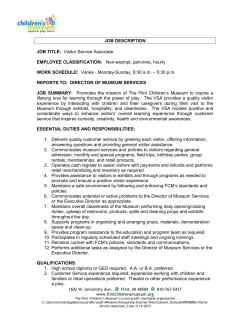
Paper F â Health Visiting position against target
Paper F Health Education East Midlands Governing Body Health Visiting Position against target ESTMENT PLAN Purpose of this paper M Multi-Professional Education and Training The purpose of this paper is to brief the Governing Body on the current East Midlands (MPET) INVESTMENT PLAN position in regard to delivering the Health Visitor Implementation Plan “A Call to Action” published in February 2011. The paper covers the following key requirements: - U Multi-Professional Education and Training The latest position of Health Visitor staff in post (FTE) against the East Midlands (MPET) target. INVESTMENT PLAN A review of the students in training and expected outcomes. l-Profess and the Training (MPET) including A summary Education of achievements during life of the programme, improvements and workforce growth. INVESTMENT PLAN service Why is it important? The East Midlands has been working hard to achieve the objectives of “A Call to Action” and in particular the target to increase the Health Visiting workforce to 1010.50 FTE by April 2015. (393.50 FTE increase from May 2010 baseline of 617.00 FTE) How it links to our strategic priorities The over-riding aim of the programme is to improve health outcomes for children. The model is based on early assessment, intervention and prevention, whereby families with more complex problems and needs receive more health visiting input and access to a range of other support services. At the most intensive tier, the model clarifies the Health Visitor’s role in identifying risk and vulnerability within families and in responding to safeguard children. What are the implications/options/possibilities/risks/consequences/impacts? The consequences of not achieving the objectives and the targets are a shortfall in appropriately trained Health Visiting Staff to carry out the services required and the LETB failing to meet national targets and standards. What action/output/come is required? The Governing Body will be informed of the latest data available on progress against target at the March 2015 meeting and provided with further information on how any remaining shortfall is being managed. 1 Suggested resolution The Governing Body are requested to receive the paper for discussion and identify how any risks in achieving the target are addressed. Jane Johnson, Deputy Director of Workforce, Education and Quality Date: March 2015 2 Health Education East Midlands Health Visitor Position against target The purpose of this paper is to brief the Governing Body on the current East Midlands position in regard to delivering the Health Visitor Implementation Plan “A call to Action” published in February 2011. The paper covers the following key requirements: A summary of the latest Health Visitor staff in post (FTE) against the East Midlands target. A summary of the students in training and expected outcomes. A summary achievements during the life of the programme, including service improvements and workforce growth. The Health Visitor workforce as at the end of December 2014 The latest available data extracted from the Electronic Staff Record (ESR) data warehouse is the end of December 2014, and shows that across the East Midlands there are 947.34 FTE Health Visitors employed in the region. This demonstrates a shortfall of 9.18 FTE against the agreed trajectory of 956.52 FTE. Analysis of the reason behind this shortfall reveals that a number of students that recently qualified still do not have their PIN and are working in Community nurse roles. The chart below shows the current position and the growth required to ensure the region meets the target. The baseline set for the East Midlands was established at 617.00 FTE in May 2010, and the target was set at 1010.50 FTE April 2015. This required a growth in the Health Visitor workforce for the region of a total 393.50 FTE by April 2015. This represents a total growth in the Health Visitor workforce of 64%, and is the second highest growth required across the regions in England. South East Coast required a growth of 79% from their baseline position. 3 The chart below shows the growth from the baseline position and the growth required to meet the target. The following summarises key achievements to date during the life of the programme: • • • A total increase for the region in the Health Visitor workforce for the region of 330.34 FTE from the original May 2010 baseline. The distance to the April 2015 target is 63.16 FTE, which is a further growth in the workforce of 6.7%. 101 Students have recently qualified and all have been offered Health Visitors posts in the East Midlands, early indications show that there are around 84 FTE commencing employment within the Health Visitor workforce in January and February 2015. The East Midlands Target for April 2015 of 1010.5 FTE remains attainable and realistic due to the following achievements: Increased retention of the current workforce. Recruitment to existing vacancies. Recruitment of Health Visitors through Return to Practice initiatives. Recruitment of bank staff into full time employment. Monitoring of newly trained Health Visitors into the workforce. Increase participation rate of newly qualified Health Visitors. Increased participation rate of Health Visitors. 4 Service Improvement The over-riding aim of the programme is to improve health outcomes for children and HEEM have worked with NHS England to facilitate a regional programme of service transformation. The model is based on early assessment, intervention and prevention, whereby families with more complex problems and needs receive more health visiting input and access to a range of other support services. At the most intensive tier, the model clarifies the Health Visitor’s role in identifying risk and vulnerability within families and in responding to safeguard children. During the life of the programme key performance metrics have been developed and reported against and have shown improvement in access to key aspects of the Healthy Child programme across the health visiting service as a result of the workforce growth. Achievements HEEM have worked with service providers to put the following actions in place: Establish requirements for additional Community Practice Teachers (CPT) and funding is in place for CPT training as required to meet the needs of the service. Worked to develop an ‘arm’s length’ model of CPT practice and are developing the skills of our Health Visitor mentors to support the increase in students. Developed a four tier approach to return to practice (RtP) and have developed additional programmes at our HEI providers generating a robust response to our RtP campaign and trained 25 RtP students in 2011/12. Service providers continue to include RtP students within their training commission target. Developed a leadership programme for health visitors in conjunction with the East Midlands Leadership Academy; 16 cohorts have been completed over the last 3 years. Developed a Health Visitor Master Class programme for managers, 4 cohorts have been completed. Establishment of a regional team with the responsibility for programme delivery. Development of a regional network group that includes HEIs, Service Providers, Public Health, Service Commissioning and. LETB colleagues. Regular stakeholder meetings since February 2011 so key people have got to know each other better and now work more effectively outside of the meetings. Challenges are taken to the meetings and presented for collective solutions to be reached. A shared goal from the onset of the programme and being clear about this being everyone’s responsibility to achieve desired outcomes and very close performance management from the regional programme team. Growing the workforce Excellent data management which includes: - undertaking the student survey for all Health Visitor students to understand their aspirations post qualification, and experience of the learning environment - The establishment of effective information on training starters and completers. Development of collaboration with Local Area Team commissioners including a shared understanding on terminology to minimise the data differences across the region 5 Professional Mobilisation Leadership Programme for Health Visitor and School Nursing System Leaders Competency Framework pilots for Health Visiting teams Use of Social Media to engage with area teams and providers and keep service users and providers updated on developments e.g. Health Visitor Monthly, Twitter and Facebook, Health visiting website. Interview skills Webinars to support the Health Visitor students in getting jobs and to support good candidates to access Health Visiting training. Joint bidding with NHS England for funds from their Transformation Funding to support providers with the implementation of Ages and Stages tools in practice Supporting providers in developing Workforce development skills in order to engage more with the LETB’s in the planning of Education commissions. Early survey of applicants and students experience in accessing the Health Visitor course and subsequent development of a consistent recruitment process across the four education providers in Yorkshire and Humber area has been important. Aligning Service Delivery East Midlands developed a bespoke Building Community Capacity module with Sheffield Hallam University that allowed Health Visitors to develop and deliver specific projects to support service improvement HEEM supported funding for 7 part-time Clinical Associate roles over the 4 years that supported specific projects to ensure the service elements of the Implementation Plan were developed and enabled the delivery of the Health Visiting Implementation Plan 3.’Celebrating Health Visiting in the East Midlands’ Conference was held on 4 February 2015, to share good practice, innovation and acknowledge achievements during a Call to Action CONCLUSION HEEM is assured that our regional implementation plan is achievable and feasible for our Area Team’s and Providers going forward through to April 2015. The life of this programme has demonstrated key achievements in workforce growth and service improvements. 6
© Copyright 2025










